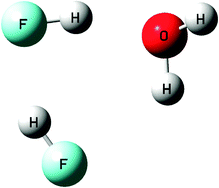A comparative computational study of the cooperative effect of hydrogen-, lithium- and halogen-bonding on model F–H and F–Li complexes with H2O was undertaken at the MP2/6-311++G(d,p) level of theory. The general trend of increased attraction or a positive cooperative effect on introduction of a third molecule to the F–H/Li⋯OH2 dimer shows that lithium bonding has the greatest effect, followed by hydrogen bonding and then halogen bonding. The computed three-body nonadditive energy has a more substantial contribution to the interaction energy of the cyclic trimers than to the open linear trimer clusters.

